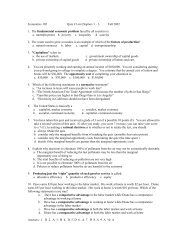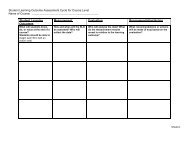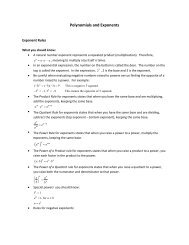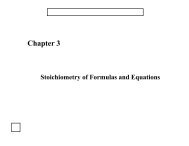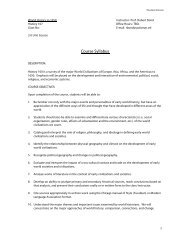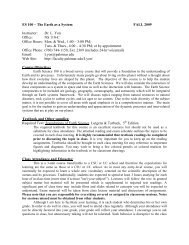01_Art165_TempTitlePage5ed [Converted] - Palomar College
01_Art165_TempTitlePage5ed [Converted] - Palomar College
01_Art165_TempTitlePage5ed [Converted] - Palomar College
Create successful ePaper yourself
Turn your PDF publications into a flip-book with our unique Google optimized e-Paper software.
temporary<br />
This Temporary Course Packet will<br />
only get you through the first week<br />
or two of class. Buy the regular<br />
Course Packet in the bookstore as<br />
soon as possible!
history of art I temporary course packet<br />
introduction<br />
This temporary History of Art I Course Packet (Fifth Edition) was researched and<br />
produced by Professor Mark Hudelson at <strong>Palomar</strong> <strong>College</strong> in San Marcos,<br />
California (©2<strong>01</strong>2). It is intended as a supplement to Adams’ Art Across Time,<br />
Volume I (Fourth Edition). Please purchase the COMPLETE course packet in the<br />
bookstore as soon as you can.<br />
In this temporary course packet, there are four types of materials: chapter guides,<br />
study guides, video guides and test guides.<br />
Chapter guides parallel the chapters in Adams. In class, when your instructor<br />
shows you a work of art listed in a chapter guide, put a check mark by it. Now you<br />
have all of the facts about that work (its correct spelling for artist and title, its size, its<br />
material, etc.) and you can focus your note taking on the lecture. This also saves<br />
your instructor from having to write everything on the board.<br />
Study guides summarize major art concepts or periods. Your instructor may have<br />
you fill a study guide out in class or you may be assigned to fill in the answers as<br />
homework. The answers to the study guides are on my website:<br />
http://www2.palomar.edu/users/mhudelson/<br />
From my homepage, click on “Art 165” and then on “study guides.”<br />
Video guides correspond to videos you may see in class. Just answer the<br />
questions in the video guide as those points are addressed in the video. Your<br />
instructor may have you fill out these guides together in class or assign the<br />
questions as homework. The answers to the video guide questions are on my<br />
website. Again, click on “Art 165” and then on “video guides.” Many of these videos<br />
can also be found on my YouTube channel:<br />
http://www.youtube.com/arthistoryprof<br />
Test guides provide you with terms to study for the quizzes, as well as hints on how<br />
to prepare for the midterms and final exam.<br />
All of these items (chapter, study, video and test guides) will help you in taking<br />
notes and in preparing for the tests. I hope you find this temporary course packet<br />
useful.<br />
-Prof. Mark Hudelson<br />
Page: i
history of art I temporary course packet<br />
table of contents<br />
Chapter Guide: Introduction .............................................................................................................. 1.<br />
Chapter Guide: The Art of Prehistory ................................................................................................ 4.<br />
Study Guide: Paleolithic vs. Neolithic .................................................................................................... 8.<br />
Video Guide: Archaeology: Cave Beneath the Sea .............................................................................. 9.<br />
Video Guide: Secrets of Lost Empires: Stonehenge .......................................................................... 11.<br />
Page: ii
works of art and architecture<br />
chapter guide: introduction<br />
introduction<br />
why do we study art history?<br />
1. Vincent VAN GOGH. Self-Portrait before His Easel, 1888. Oil on canvas; 25 ¾ x 19 7/8”.<br />
2. “Western art”<br />
3. pictures, sculpture, architecture<br />
the artistic impulse<br />
4. portrait<br />
5. Albrecht DÜRER. Self-Portrait, 1500. Oil on panel; 26 1/4 x 19 1/4”.<br />
6. “Mask of Agamemnon,” from Mycenae, c. 1500 B.C. Beaten gold; approx. 12” high.<br />
7. patron<br />
8. Bodyguard of the emperor of Qin, terra-cotta warriors, Qin dynasty (221-206 B.C.), in situ.<br />
Lintong, Shaanxi Province, China.<br />
9. terra-cotta<br />
10. IKTINOS and KALLIKRATES. East end of the Parthenon, Athens, 447-438 B.C. Pentelic<br />
marble; 111 x 237’.<br />
11. Taj Mahal, Agra, India, 1632-1648.<br />
12. icon<br />
13. aesthetic<br />
why is art valued?<br />
material value<br />
intrinsic value<br />
14. LEONARDO da Vinci. Mona Lisa, c. 1503-1505. Oil on wood; 30 1/4 x 21”.<br />
15. Constantin BRANCUSI. Bird in Space, 1928. Bronze, unique cast; 54 x 8 1/2 x 6 1/2”.<br />
16. ziggurat<br />
religious value<br />
nationalistic value<br />
17. Arch of Constantine, Rome, c. 313 A.D.. Marble; 70’ high, 85’8” wide.<br />
18. Lapith and Centuar, from south metope XXVII of the Parthenon. Pentelic marble; 4’5” high.<br />
psychological value<br />
19. Diego VELÁZQUEZ. Venus with a Mirror (Rokeby Venus), c. 1648. Oil on canvas;<br />
4’ 3/8” x 5’9 5/8”.<br />
©2<strong>01</strong>2 Mark Hudelson Page: 1 Use with Adams/4 th ed.<br />
= art from Adams; = art not from Adams; = term; underline and/or italics = title to memorize for exam
art and illusion<br />
1. naturalism<br />
2. representational or figurative<br />
3. illusionism<br />
4. trompe-l’oeil<br />
5. René MAGRITTE. The Betrayal of Images (“This is not a pipe”), 1928. Oil on canvas;<br />
23 ½ x 28 ½”.<br />
6. Duane HANSON. The Cowboy, 1995. Polyester resin polychromed in oil; lifesize.<br />
artists and gods<br />
7. God as Architect (God Drawing the Universe with a Compass), from the Bible moralisée,<br />
Reims, France, fol. lv, mid-13 th century. Illumination; 8 1/3” wide.<br />
8. Pieter BRUEGEL the Elder. The Tower of Babel, 1563. Tempera on panel; 3’9” x 5’1”.<br />
art and identification<br />
reflections and shadows: legends of how art began<br />
9. fired<br />
10. Joseph WRIGHT of Derby. The Corinthian Maid, 1782-1784. Oil on canvas; 41 7/8 x<br />
51 1/2”.<br />
image magic<br />
11. George CATLIN. The White Cloud, Head Chief of the Iowas, 1844-1845. Oil on canvas;<br />
28 x 22 7/8”.<br />
12. James Abbott McNeill WHISTLER. Arrangement in Black and Gray (Portrait of the<br />
Artist’s Mother), 1871. Oil on canvas; 4’9” x 5’4 1/2”.<br />
13. landscape<br />
14. still life<br />
15. nonrepresentational<br />
architecture<br />
16. Great Stupa at Sanchi, Madhya Pradesh, India, Shunga and early Andhra periods,<br />
3 rd century B.C. Diameter over 120’.<br />
17. stupa<br />
18. circumambulation<br />
19. garbha griha<br />
20. Jan VAN EYCK. The Virgin in a Church, c. 1410-1425. Oil on panel; 12 1/4 x 5 1/2”.<br />
21. diptych<br />
22. Plan of the Parthenon, Athens.<br />
23. ground plan<br />
©2<strong>01</strong>2 Mark Hudelson Page: 2 Use with Adams/4 th ed.<br />
= art from Adams; = art not from Adams; = term; underline and/or italics = title to memorize for exam
1. stratigraphy<br />
2. seriation<br />
3. dendrochronology<br />
4. radiocarbon dating<br />
5. archaeometry<br />
why do we collect art?<br />
archaeology and art history<br />
how do we approach art?<br />
the methodologies of art<br />
6. formalism<br />
7. Meret OPPENHEIM. Fur-covered Cup, Saucer, and Spoon (Le Déjeuner en Fourrure),<br />
1936. Cup 4 3/8” diameter; saucer 9 3/8” diameter; spoon 8” long; overall height 2 7/8”.<br />
8. iconography<br />
9. iconology<br />
10. West façade of Chartres Cathedral, c. 1140-1150.<br />
11. program<br />
12. Marxism<br />
13. feminism<br />
14. biography<br />
15. autobiography<br />
16. semiology<br />
17. deconstruction<br />
18. psychoanalysis<br />
19. formal elements<br />
20. style<br />
21. composition<br />
22. plane<br />
23. picture plane<br />
24. plane of relief<br />
how do we talk about art?<br />
composition<br />
plane<br />
25. balance<br />
26. symmetry<br />
27. asymmetrical balance<br />
balance<br />
line<br />
28. Lines.<br />
29. Alexander CALDER. Cat (detail), 1943. Full work 22 x 30”.<br />
©2<strong>01</strong>2 Mark Hudelson Page: 3 Use with Adams/4 th ed.<br />
= art from Adams; = art not from Adams; = term; underline and/or italics = title to memorize for exam
shape<br />
1. Shapes.<br />
2. biomorphic<br />
3. Drawing of solid shapes showing hatching and crosshatching.<br />
4. modeling<br />
5. hatching or crosshatching<br />
6. shading<br />
light and color<br />
7. Diagram showing a beam of light through a prism.<br />
8. hues<br />
9. primary colors<br />
10. secondary colors<br />
11. tertiary colors<br />
12. The color wheel.<br />
13. color wheel<br />
14. complementary colors<br />
15. Ten-step value scale.<br />
16. value<br />
17. achromatic<br />
18. Color value scale.<br />
19. chromatic<br />
20. intensity or saturation<br />
texture<br />
stylistic terminology<br />
21. content<br />
22. naturalistic<br />
23. realistic<br />
24. illustionistic<br />
25. Theo VAN DOESBURG. Study 1 for Composition (The Cow), 1916. Pencil on paper;<br />
4 5/8 x 6 ¼”.<br />
26. Theo VAN DOESBURG. Study 2 for Composition (The Cow), 1917. Pencil on paper;<br />
4 5/8 x 6 ¼”.<br />
27. Theo VAN DOESBURG. Study 3 for Composition (The Cow), 1917. Pencil on paper;<br />
4 5/8 x 6 ¼”.<br />
28. Theo VAN DOESBURG. Study for Composition (The Cow), c. 1917 (dated 1916).<br />
Tempera, oil, and charcoal on paper; 15 5/8 x 22 ¾”.<br />
29. idealized<br />
30 stylized<br />
31. romanticized<br />
32. nonrepresentational or nonfigurative<br />
33. abstract<br />
34. Theo VAN DOESBURG. Study for Composition (The Cow), c. 1917. Oil on canvas;<br />
14 3/4 x 25”.<br />
©2<strong>01</strong>2 Mark Hudelson Page: 4 Use with Adams/4 th ed.<br />
= art from Adams; = art not from Adams; = term; underline and/or italics = title to memorize for exam
chapter guide: part one, chapter one<br />
the art of prehistory<br />
chronology<br />
THE OLD STONE AGE (Paleolithic), c. 500,000-8,000 B.C.<br />
•c. 25,000 B.C.: cave paintings at Chauvet, France.<br />
•c. 15,000-10,000 B.C.: cave paintings at Altamira, Spain.<br />
•c. 15,000-10,000 B.C.: cave paintings at Lascaux, France.<br />
THE MIDDLE STONE AGE (Mesolithic), c. 8,000-6,000/4,000 B.C.<br />
THE NEW STONE AGE (Neolithic), c. 6,000/4,000-2,000 B.C.<br />
•c. 7,000-6,500 B.C.: “Neolithic Revolution.”<br />
•c. 7,000 B.C.: Jericho, Jordan.<br />
•c. 5,600-3,500 B.C.: Chalcolithic Period (Copper-Stone Age), first metalwork.<br />
•c. 6,000 B.C.: Çatal Hüyük, Turkey.<br />
•c. 2800-1500 B.C.: Stonehenge, Salisbury Plain, England.<br />
•c. 2300-1000 B.C.: Bronze Age.<br />
•c. 1,000 B.C.-100 A.D.: Iron Age.<br />
works of art and architecture<br />
1. prehistory<br />
2. Paleolithic<br />
3. nomadic<br />
the stone age in western europe<br />
upper paleolithic (c. 50,000/45,000 - c. 8,000 B.C.)<br />
upper paleolithic sculpture<br />
4. Venus of Willendorf, from Willendorf, Austria, c. 25,000-21,000 B.C. Limestone; 4 3/8” high.<br />
5. carved/carving<br />
6. sculpture in the round<br />
7. relief<br />
8. high relief<br />
9. low relief<br />
10. sunken<br />
11. female fertility figurine<br />
12. Venus of Savignano , from Modena, Italy. c. 25,000 B.C. Serpentine stone; height 8 3/4”.<br />
13. Venus of Lespugue, from France. c. 24,000-18,000 B.C. Wooly mammoth tusk; height 6”.<br />
14. Venus of Hohle Fels, from Germany. c. 33,000-38,000 B.C. Wooly mammoth tusk;<br />
2 1/3” high.<br />
15. Venus of Laussel, from Laussel, Dordogne, France, c. 25,000-23,000 B.C. Limestone;<br />
17 3/8” high.<br />
©2<strong>01</strong>2 Mark Hudelson Page: 5 Use with Adams/4 th ed.<br />
= art from Adams; = art not from Adams; = term; underline and/or italics = title to memorize for exam
1. pigment<br />
2. medium or vehicle or binder<br />
3. Bison with turned head, from La Madeleine, Tarn, France, c. 11,000-9000 B.C. Reindeer<br />
horn; 4 1/8” long.<br />
4. incised<br />
5. Bison, Tuc d’Audoubert cave, Ariège, Dordogne, France, c. 13,000-8000 B.C. Unbaked<br />
clay; each animal approx. 2’ long.<br />
6. modeled<br />
upper paleolithic painting in spain and france (c. 30,000 - c. 10,000 B.C.)<br />
7. Jellyfish, Cosquer cave, near Marseilles, France, c. 25,000 B.C. Painting on a black<br />
stalagmite.<br />
8. Hyena and panther, Chauvet cave, Ardèche Valley, France, c. 25,000-17,000 B.C. Red<br />
ocher on limestone wall.<br />
9. Mammoths and horses, Chauvet cave, Ardèche Valley, France, c. 25,000-17,000 B.C.<br />
Engraving on limestone wall.<br />
10. Left section of the “Lion Panel,” Chauvet cave, Ardèche Valley, France,<br />
c. 25,000-17,000 B.C. Black pigment on limestone wall.<br />
11. Handprints, Pech-Merle, Dordogne, France, c. 16,000 B.C.<br />
12. shamans<br />
13. animism<br />
14. Shaman, Trois-Frères cave, Ariège, Dordogne, France, c. 13,000-11,000 B.C. 24” high.<br />
15. Drawing by Henri Breuil (of the shaman from Trois-Frères cave).<br />
16. Diagram of the Lascaux cave system.<br />
17. Hall of Running Bulls, Lascaux, Dordogne, France, c. 15,000-13,000 B.C. Paint on<br />
limestone rock; individual bulls 13-16’ long.<br />
18. Axial Gallery, Lascaux, Dordogne, France, c. 15,000-10,000 B.C.<br />
19. “Chinese Horse,” Lascaux, Dordogne, France, c. 15,000-13,000 B.C. Paint on limestone<br />
rock; horse 5’6” long.<br />
20. Reindeer, Lascaux, Dordogne, France, c. 15,000-13,000 B.C. Paint on limestone rock.<br />
21. Ceiling view, Altamira cave, Spain, c. 12,000 B.C.<br />
22. Wounded Bison, Altamira cave, Spain, c. 15,000-10,000 B.C.<br />
23. Standing bison, Altamira cave, Spain, c. 12,000 B.C. 6 x 5’.<br />
window on the world one<br />
rock paintings of australia (c. 75,000/50,000 B.C.)<br />
24. Wandjina, Rowalumbin, Barker River, Napier Range, Kimberley, Australia.<br />
25. Mimi hunters, Kakadu National Park, Arnhem Land, Northern Territory, Australia. Rock<br />
painting.<br />
26. Men and women hunting kangaroos, Unbalanya Hill, Arnhem Land, Northern Territory,<br />
Australia. Rock painting.<br />
27. Kangaroo with Lightning Man, Nourlangie Rock, Kakadu National Park, Arnhem Land,<br />
Northern Territory, Australia. Rock painting.<br />
28. polychrome<br />
©2<strong>01</strong>2 Mark Hudelson Page: 6 Use with Adams/4 th ed.<br />
= art from Adams; = art not from Adams; = term; underline and/or italics = title to memorize for exam
mesolithic (c. 8,000-c. 6,000/4,000 B.C.)<br />
1. Mesolithic<br />
2. Saharan rock painting, Tassili, Algeria, Cattle or Pastoralist period, 5 th -4 th millennium B.C.<br />
neolithic (c. 6,000/4,000 - c. 2,000 B.C.)<br />
malta<br />
3. Neolithic<br />
4. Neolithic Revolution<br />
5. Fertility Goddess, from Cernavoda, Romania. c. 5000 B.C. Baked clay.<br />
6. Reconstruction drawing of the temple at Ggantija, Gozo, Malta.<br />
7. megalith<br />
8. façade<br />
9. necropolis<br />
10. “Mother goddess,” Tarxien, Malta, before 2500 B.C. Stone fragment.<br />
11. “Sleeping Lady,” Hal Saflieni, Malta, before 2500 B.C. Terra-cotta; 4 4/5”.<br />
northern europe<br />
12. menhir<br />
13. dolmen<br />
14. cromlech<br />
15. monoliths<br />
16. Alignment of menhirs, Carnac, Britany, France, c. 4000 B.C. Stone; 6-15’ high.<br />
17. Dolmen, Carnac, Brittany, France, c. 4000 B.C.<br />
18. Stonehenge, Salisbury Plain, England, c. 2800-1500 B.C. Diameter of circle 97’; height<br />
approx. 13’6”.<br />
19. sarsens<br />
20. Plan of Stonehenge.<br />
21. Heel Stone<br />
22. Altar Stone<br />
23. Aubrey Holes<br />
24. Post-and-lintel construction.<br />
25. post-and-lintel construction<br />
26. trilithon<br />
27. Lintel and tenon.<br />
28. mortice<br />
29. tenon<br />
30. The inside ring of Stonehenge.<br />
©2<strong>01</strong>2 Mark Hudelson Page: 7 Use with Adams/4 th ed.<br />
= art from Adams; = art not from Adams; = term; underline and/or italics = title to memorize for exam
study guide (answers: www2.palomar.edu/users/mhudelson. Click on “Art 165,” then “Study Guides.”)<br />
paleolithic vs. neolithic<br />
“Paleo”=<br />
“lithic”=<br />
Nomadic=<br />
“Neo”=<br />
“lithic”=<br />
Neolithic Revolution=<br />
Hunt or farm?<br />
Dwellings:<br />
Permanent<br />
structures<br />
built?<br />
Tools:<br />
Clothes:<br />
Art:<br />
Sculpture<br />
material:<br />
©2<strong>01</strong>2 Mark Hudelson Page: 8 Use with Adams/4 th ed.<br />
= art from Adams; = art not from Adams; = term; underline and/or italics = title to memorize for exam
video guide (answers: www2.palomar.edu/users/mhudelson. Click on “Art 165,” then “Video Guides.”)<br />
archaeology:<br />
“cave beneath the sea”<br />
1. The underwater Cosquer cave was named after __________.<br />
A) The prehistoric painter who signed the works, Gorg Cosquer.<br />
B) The French president, François Cosquer.<br />
C) Its discoverer, Henri Cosquer.<br />
D) The nearby body of water, the Cosquer Sea.<br />
2. When was Cosquer cave discovered?<br />
A) 1897.<br />
B) 1907.<br />
C) 1985.<br />
D) 1996.<br />
3. Many of the painted animals in Cosquer cave, such as horses, deer and bison, were familiar. Others were<br />
more exotic, such as the long-extinct giant, Irish elk and the Auk, a __________.<br />
A) Giant, Irish Setter.<br />
B) Saber-toothed chipmunk.<br />
C) Woolly pig.<br />
D) Flightless sea-bird.<br />
4. The crystallized, calcite drippings that cover the lines of etchings and paintings in Cosquer cave prove that the<br />
paintings __________.<br />
A) Were painted by left-handed artists.<br />
B) Are genuine.<br />
C) Are fakes.<br />
D) Were covered by calcite for protection by the prehistoric painters.<br />
5. Radiocarbon dating shows that the animal paintings in Cosquer cave were created after the __________<br />
paintings.<br />
A) Landscape.<br />
B) Naked.<br />
C) Foot.<br />
D) Hand.<br />
6. During the __________, people were primarily hunters and gatherers.<br />
A) Ice Age.<br />
B) Dinosaur Age.<br />
C) Cave Age.<br />
D) Egyptian period.<br />
7. One of the theories put forth to explain cave paintings is that prehistoric men would cast spells on animals by<br />
__________ on the cave walls.<br />
A) Killing their symbols.<br />
B) Urinating.<br />
C) Pasting animal skins.<br />
D) Painting their pets.<br />
©2<strong>01</strong>2 Mark Hudelson Page: 9 Use with Adams/4 th ed.<br />
= art from Adams; = art not from Adams; = term; underline and/or italics = title to memorize for exam
8. What else may the painted animals on cave walls have represented, besides just a meal for prehistoric<br />
people?<br />
A) Animals that had been domesticated.<br />
B) The various seasons in which the animals first made their appearance.<br />
C) The various emotions associated with the animals.<br />
D) Prehistoric sports teams, such as the Cosquer Auks and the Lascaux Bison.<br />
9. By observing __________, French prehistorian Michel Lorblanchet gained insights into the technique of<br />
blowing pigment onto the wall to create paintings.<br />
A) Politicians.<br />
B) Abstract Expressionists.<br />
C) Blowfish.<br />
D) Australian, aboriginal rock painters.<br />
10. What is the site of the greatest cave art sanctuary of them all?<br />
A) Lascaux.<br />
B) Cosquer.<br />
C) Egypt.<br />
D) Stonehenge.<br />
11. Some 275 cave painting sites are known, concentrated mainly in southern France and northern<br />
__________.<br />
A) California.<br />
B) England.<br />
C) Spain.<br />
D) Russia.<br />
12. Some people believe the missing finger joints visible in some prehistoric hand prints are the result of<br />
disease or frostbite, while others believe the “missing” fingers are really __________.<br />
A) A form of hunting sign language.<br />
B) Part of a mutilation cult.<br />
C) The result of machinery accidents.<br />
D) Evidence of carnivorous cave plants.<br />
13. Most Ice Age people were lucky to survive into their __________.<br />
A) 30s.<br />
B) 40s.<br />
C) 50s.<br />
D) 60s.<br />
14. The French Navy has blocked the entrance to Cosquer cave to protect both the fragile art and<br />
__________.<br />
A) The priceless calcite drippings.<br />
B) Henri Cosquer’s privacy, since the cave is now his home.<br />
C) Those attempting the deadly underwater entry.<br />
D) The nuclear weapons the Navy now stores there.<br />
©2<strong>01</strong>2 Mark Hudelson Page: 10 Use with Adams/4 th ed.<br />
= art from Adams; = art not from Adams; = term; underline and/or italics = title to memorize for exam
video guide (answers: www2.palomar.edu/users/mhudelson. Click on “Art 165,” then “Video Guides.”)<br />
secrets of lost empires:<br />
“stonehenge”<br />
1. Where is Stonehenge?<br />
A) Southern California.<br />
B) Southern England.<br />
C) Southern France.<br />
D) Southern Spain.<br />
2. At Stonehenge, the horizontal stones, or lintels, are __________.<br />
A) Covered with graffiti.<br />
B) Held in place with modern supports.<br />
C) Almost perfectly level.<br />
D) Angled toward the constellation of Orion.<br />
3. The largest stone at Stonehenge has about 25 feet showing above ground, and about __________ feet<br />
underground.<br />
A) 2.<br />
B) 4.<br />
C) 6.<br />
D) 8.<br />
4. There is no natural source for large stones near Stonehenge. True or false?<br />
5. What is the term for the very hard sandstone blocks that were used at Stonehenge?<br />
A) Hardus Blockus Sandstonus.<br />
B) Concrete.<br />
C) Steelstone.<br />
D) Sarsens.<br />
6. What is the problem with moving large stone blocks on log rollers?<br />
A) The blocks always roll off the logs.<br />
B) The logs make the blocks move too fast to control.<br />
C) The blocks would crush the logs.<br />
D) Too many logs would have been needed to move the many blocks at Stonehenge.<br />
7. Instead of using log rollers, the builders of Stonehenge may have greased wooden rails with __________ to<br />
move the stones.<br />
A) Blood.<br />
B) Animal fat.<br />
C) Saliva.<br />
D) Crisco.<br />
8. What did the builders of Stonehenge use to make rope for pulling their stones into position?<br />
A) Wood bark fibers.<br />
B) Horse hair.<br />
C) Strong wheat shafts.<br />
D) Bison ligament.<br />
©2<strong>01</strong>2 Mark Hudelson Page: 11 Use with Adams/4 th ed.<br />
= art from Adams; = art not from Adams; = term; underline and/or italics = title to memorize for exam
9. What may have been used as a counter-weight to tip the larger stones into slanted pits?<br />
A) A woolly mammoth.<br />
B) The Venus of Willendorf.<br />
C) Smaller stones.<br />
D) Log rollers.<br />
10. Which of the following used to be near Stonehenge?<br />
A) Tombs for rich people.<br />
B) A Paleolithic cave with paintings.<br />
C) A pit for catching bison.<br />
D) A cliff wall from which the stones were quarried.<br />
11. How are the stones at Stonehenge held together?<br />
A) Rope binding.<br />
B) Cement.<br />
C) Animal fat used as glue.<br />
D) Projections on the uprights fit into holes in the lintels.<br />
12. Stonehenge is arranged around a central axis that points toward __________.<br />
A) The North Star.<br />
B) The rising sun on the summer solstice.<br />
C) <strong>Palomar</strong> <strong>College</strong>.<br />
D) The Great Pyramid in Egypt.<br />
13. On the summer solstice, the sun rises above the __________ at Stonehenge.<br />
A) Heel stone.<br />
B) Sun stone.<br />
C) Limestone.<br />
D) Rolling stone.<br />
14. Stonehenge may align with the moon and stars. True or false?<br />
15. Stonehenge may have served as a kind of crude __________ for Neolithic farmers.<br />
A) Irrigation system.<br />
B) Animal pen.<br />
C) Corn silo.<br />
D) Calendar.<br />
16. Stonehenge was likely built as a __________.<br />
A) Palace.<br />
B) Temple.<br />
C) Tomb.<br />
D) Amphitheater.<br />
17. How were the crossing lintels likely put into place?<br />
A) Using a steep ramp.<br />
B) Using pulleys.<br />
C) Using a kind of conveyor belt.<br />
D) Using a big catapult.<br />
18. Archaeology can help us answer all of the following questions about Stonehenge except:<br />
A) When was it built?<br />
B) What was the society like that built it?<br />
C) What kind of engineering was used to build it?<br />
D) Why is there such a mystique to Stonehenge?<br />
©2<strong>01</strong>2 Mark Hudelson Page: 12 Use with Adams/4 th ed.<br />
= art from Adams; = art not from Adams; = term; underline and/or italics = title to memorize for exam


![01_Art165_TempTitlePage5ed [Converted] - Palomar College](https://img.yumpu.com/24489779/1/500x640/01-art165-temptitlepage5ed-converted-palomar-college.jpg)
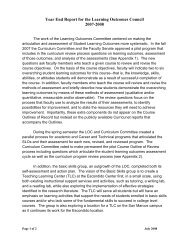

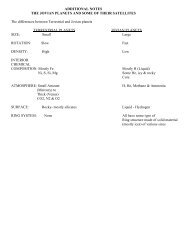
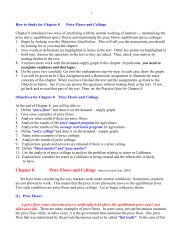
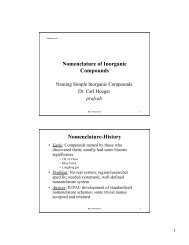
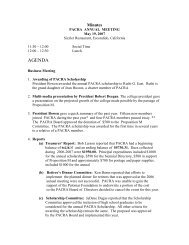
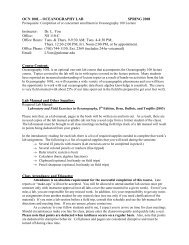
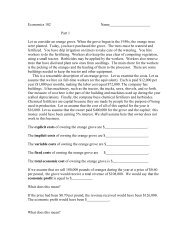
![Ch. 3 [pdf]](https://img.yumpu.com/49528659/1/190x245/ch-3-pdf.jpg?quality=85)
